Executive Summary
The 2025 Polish presidential elections are taking place at a critical moment in Poland’s political landscape. Public tensions stemming from the 2023 shift in government power, ongoing uncertainty surrounding the rule of law, and geopolitical factors such as the Russian war against Ukrainian and foreign political influences all contribute to a contested climate. The president’s authority to veto bills — combined with the lack of a parliamentary majority to override such vetoes1 — has meant that changes to the rule of law system, particularly in the judiciary, announced by the government elected in 2023, have not been implemented. The election of a new president is therefore closely tied to the future direction of reforms and the maintenance of the current status quo. Moreover, the president, as a co-authority in conducting the country’s foreign policy, will need to take a position on ongoing international geopolitical tensions, including the Russian war and the roles of actors such as the European Union and the United States. Finally, concerns about the presidential election are also linked to the issue of the Supreme Court — specifically, the Chamber of Extraordinary Control and Public Affairs—which is not recognized by some legal experts and European courts.2 This body will rule on the validity of the presidential election.
Thirteen candidates officially registered for the 2025 presidential election — the highest number since 1995. Almost all of them have official accounts on major social media platforms, including Facebook, Instagram, X, and TikTok. Most candidates, especially those who were leading in the polls, conducted simultaneous campaigns across all these platforms, with a particular emphasis on Facebook and X. In this brief, we provide an overview of their online activity, highlighting significant differences in campaigning styles, levels of engagement, and topics covered.
Key findings
- The four candidates most active on social media during the first-round campaign were Szymon Ho’0142ownia, Magdalena Biejat, S’0142awomir Mentzen and Grzegorz Braun. Combined, their posts constitute over 57% of all candidate posts. Candidates were most likely to engage with users on Facebook and X, with TikTok being the least-used platform, accounting for less than 12% of all posts.
- The five candidates who enjoyed the most average engagement were, respectively: Joanna Senyszyn, Karol Nawrocki, S’0142awomir Mentzen, Krzysztof Stanowski, and Rafa’0142 Trzaskowski.
- Candidates such as Stanowski – a journalist and YouTuber who ran an “anti-campaign” as a form of protest against the political establishment – and Senyszyn used memes as their primary form of communication, eschewing coherent political messaging in favor of self-promoting imagery or mockery of the overall race. This campaigning style was highly popular online, as both candidates enjoyed extremely high engagement rates.
- With so many candidates in the race, over one fourth of all candidate posts included direct attacks and criticisms of their opponents. Other major topics included debates over patriotism, social welfare, relations with the EU, and foreign policy – especially regarding support for Ukraine.
- The candidate Grzegorz Braun stood out for using especially harsh and antagonistic language—often containing elements of hate speech towards Jewish and Ukrainian minorities.
Overall Findings
Posting activity:
Platform usage:
During the first round of the presidential campaign, Facebook was by far the most popular platform for candidates to interact with voters. Of the thirteen candidates, seven used it as the primary social media platform. The candidates most active on Facebook were Szymon Ho’0142ownia, Grzegorz Braun and Magdalena Biejat.
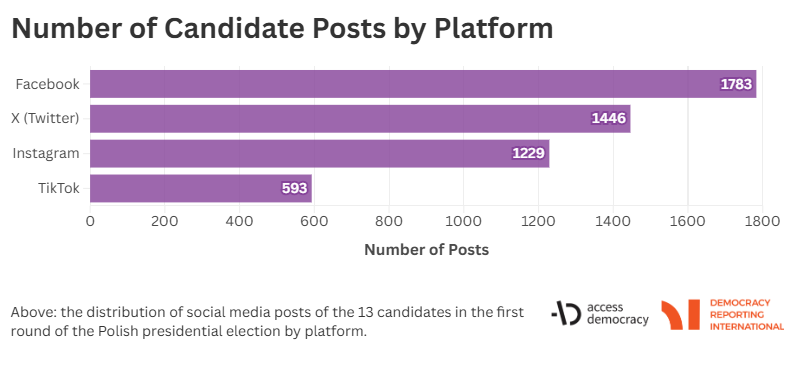
X was the second-most popular platform, with ”anti-candidate” Krzysztof Stanowski, and far-right candidates S’0142awomir Mentzen and Grzegorz Braun using it the most often. Instagram was the main posting platform only for the Left’s Magdalena Biejat. Finally, TikTok was most frequently used by Biejat and Szymon Ho’0142ownia, but only Artur Bartoszewicz used this platform as their primary method of online campaigning.
Followers
Throughout the race, the candidates showed significant variation in follower counts across different social media platforms. The candidate with the most followers on any one platform was S’0142awomir Mentzen on TikTok (1.6 million). Szymon Ho’0142ownia followed in second with 1.1 million followers on Facebook.
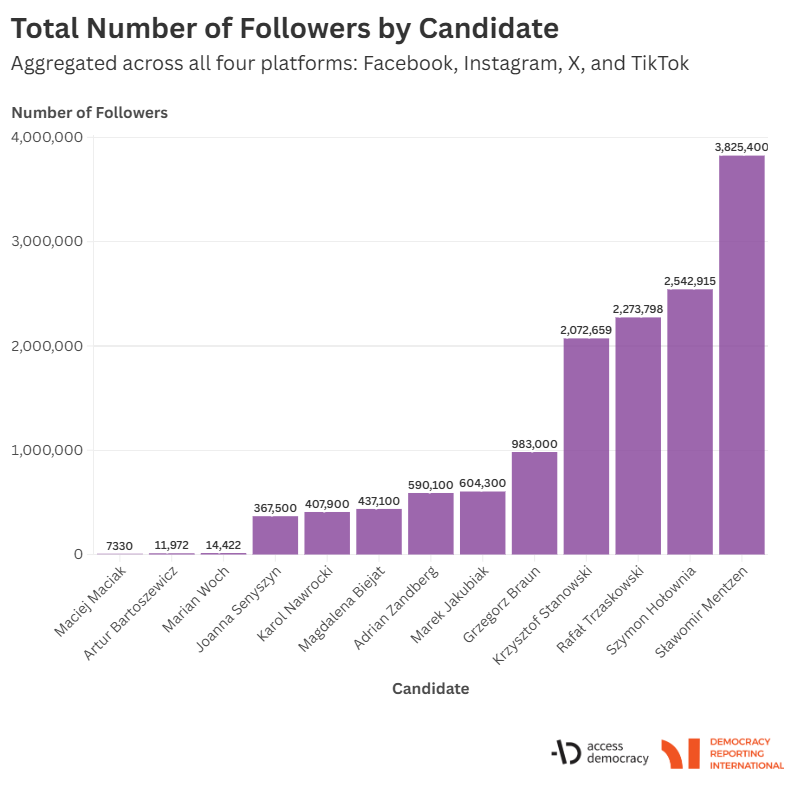
In third place, Rafa’0142 Trzaskowski, had a more balanced distribution of followers across platforms, particularly on X (897k) and Facebook (798k). Krzysztof Stanowski ranked fourth primarily due to having the largest number of followers on X among all candidates (1.3 million).
Posting Activity
During the observed period of the campaign, the candidates uploaded 5051 total posts across their social media channels. Data analysis comparing posting behavior with engagement metrics (likes, shares, and comments) showed that a high number of posts did not necessarily translate into high audience engagement.

For example, while the most active candidate was Szymon Ho’0142ownia with 803 posts – an average of about 25 entries per day on various platforms – Ho’0142ownia received very little average engagement as can be seen in the above graph. Far-right candidates Mentzen and Nawrocki, as well as centrist candidate Traskowski all enjoyed high levels of engagement per post.
Notably, Joanna Senyszyn and Krystztof Stanowski also had some of the highest levels of average engagement in the dataset, despite each receiving around 1% of votes in the first round election. Stanowski, known primarily as a YouTuber and sports journalist, framed his candidacy from the outset as an attempt to expose the world of politics. He primarily used the X platform, where he posted short, often sarcastic commentaries on current political and social events. His posts frequently mocked the presidential race and his opponents, using irony, humor, and at times vulgar language to amplify his criticisms. He also offered behind-the-scenes glimpses of the campaign, including arrangements for TV debates, often breaking the fourth wall by revealing internal discussions with campaign staff.
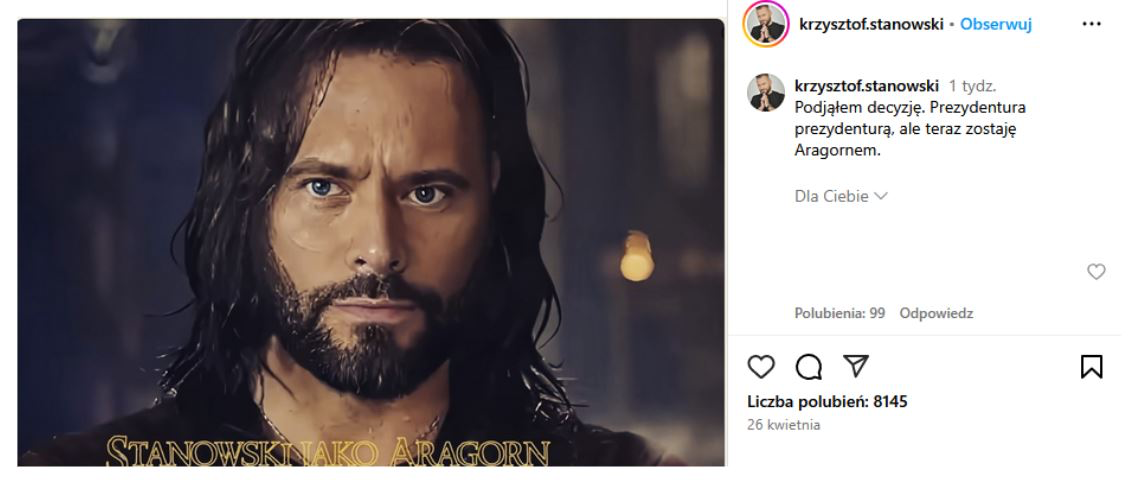
Above: A post from Stanowski’s Instagram that reads “I have made my decision. The presidency is one thing, but now I become Aragorn.”
Independent candidate Joanna Senyszyn’s campaign similarly stood out for its slightly ironic, often cabaret-like tone. Rather than engaging in a traditional, high-stakes political campaign, Senyszyn delivered a mix of self-irony, memes, and bold commentary that often bordered on political performance. At times, her activism resembled stand-up comedy, which allowed her to capture public attention despite limited resources.
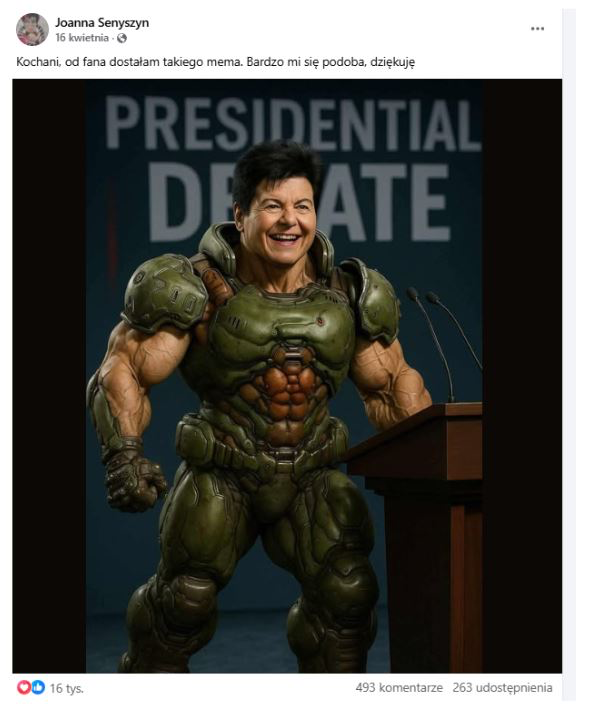
Above: A post from Joanna Senyszyn’s Facebook page – “Dear ones, I got this meme from a fan. I like it a lot, thank you”
The outsized engagement both candidates’ campaigns received highlights that while online attention is not always tied to electoral viability, it is increasingly driven by entertainment value, anti-establishment sentiment, and disruptive and irreverent communication styles. The popularity of “meme candidates” like Senyszyn and Stanowski reflects a growing online political culture where satire and spectacle can rival or even surpass traditional messaging in reach and resonance.
Topical analysis
To examine the content of candidates’ online messages, we analyzed the main topics most frequently appearing in their posts, reels, and videos. Our findings indicate that the candidates primarily focused on their own campaigns, mainly by sharing photos and videos from meetings with voters. They also frequently discussed their political opponents, with over one fifth of the total posts being classified as “criticism of opponents”.
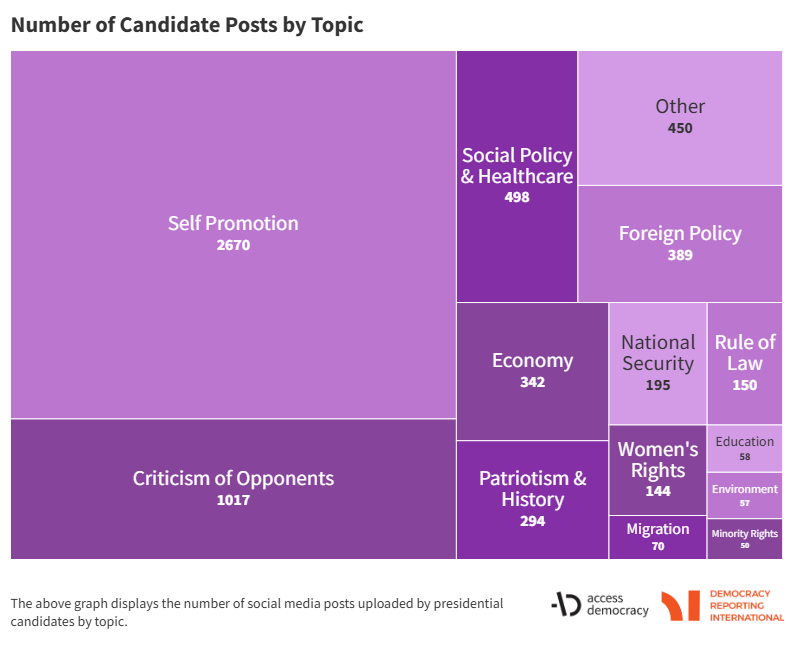
The two politicians who criticized their adversaries the most were Szymon Ho’0142ownia and S’0142awomir Mentzen. Among topics, social policy—particularly housing and healthcare—dominated the candidates’ posts. Relations with EU institutions and the United States, the economy – including issues related to taxes and infrastructure – were also frequently addressed. In contrast, topics such as women’s rights, minority rights, and migration—which featured prominently in the 2023 parliamentary campaign—were not among the main themes of this presidential race.
Sentiment
Candidate posts were further analysed using sentiment analysis, which interprets the emotional tone of posts to categorize the author’s attitude as positive, negative, or neutral. Here too we observed diverse trends in the candidates’ online communication.

Overall, most candidates uploaded more positively-toned posts than negative, with 48% of all posts in the dataset being positive in nature. These posts frequently fell into the “self-promotion” category, with candidates championing their own campaigns, interviews, and interactions with voters. Centrist candidate Rafa’0142 Trzaskowski stood out by avoiding negative messaging entirely, instead placing great emphasis on patriotism and unity. This messaging may have resonated with voters, as Trzaskowski received the most votes of any candidate and qualified for the second round of elections.
The candidates who stood out with the highest rates of negative posts were the Left (Lewica) party’s Magdalena Biejat and far-right independent Grzegorz Braun. Both candidates aimed to present themselves as expressive and distinctive politicians, regardless of sentiment type. For example, Biejat frequently use strong rhetoric against opponents, particularly Mentzen, whom she described as “a Taliban in a suit” and “a sadist, ” adding that he and his supporters “are hiding their SICK views.” She also harshly criticized Grzegorz Braun, referring to his rhetoric as “anti-Semitic sewage, ” and denounced the financial sector with phrases such as “banksters’ debauchery.” 
Text on the photos, starting from the left: “Braun’s anti-Semitic sewage!”; “The Left delivers things in government!”; “Mentzen you are a sadist.”
Braun’s social media prominently featured his high-profile stunts and harsh rhetoric, establishing him as the most controversial candidate in the race. His posts included, among other things, an “inspection” at a hospital where abortions were performed—following a high-profile case of a rare ninth-month abortion—during which he demanded explanations. He conducted a similar “inspection” at the Ministry of Industry, questioning what he described as poor management of mines and their gradual closure. During this incident, he removed the European Union flag from the ministry’s headquarters and publicly burned it. Braun also organized other provocative events, such as removing Ukrainian flags from public office buildings, which had been displayed as an expression of solidarity with Ukraine. He also frequently issued xenophobic statements regarding Jews, the European Union and Ukraine. Braun’s rhetoric can be considered to be highly anti-Semitic, drawing from traditional tropes such as the alleged influence of Jewish circles on Polish politics.
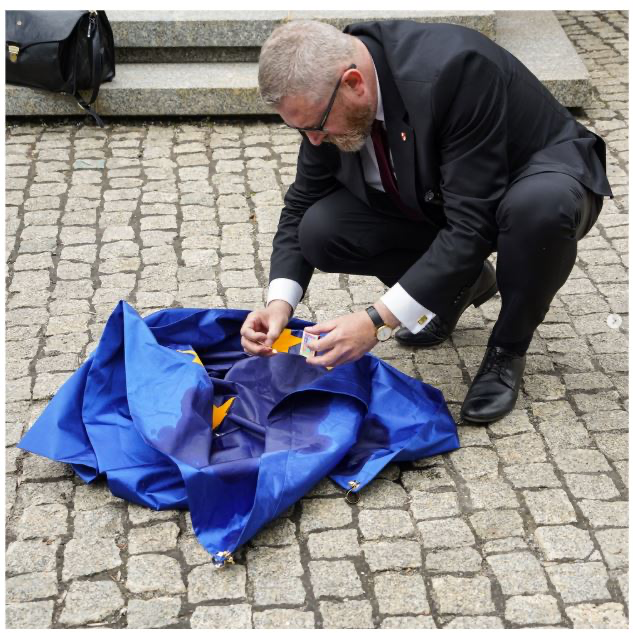
Source: Instagram profile, Grzegorz Braun
Methodology
For our analysis of the first round of the presidential elections, IPA conducted an in-depth content and engagement analysis of candidate communications across four major social media platforms – Facebook, Instagram, X, and TikTok. Between 16 April and 16 May 2025, we collected 5051 posts from the official accounts of all thirteen presidential candidates. In addition to collecting the post content, our dataset also included the sentiment, narratives, and engagement statistics (likes, retweets, shares, comments, reactions) of each post. Each post was qualitatively assessed, with topics and sentiment being labeled according to a uniform codebook.
Conclusion
The first round of the Polish presidential campaign revealed a deeply fragmented political landscape in the country, with different candidates adopting markedly different strategies and tones—from serious policy proposals and grassroots engagement to satirical and confrontational anti-campaigns. While some candidates relied on high-frequency posting and professional content to boost visibility, others leaned on controversy, clout, symbolism, or niche appeal to stand out.
With the first round concluded, only Rafa’0142 Trzaskowski and Karol Nawrocki remain in the presidential runoff, marking a stark contrast between an experienced centrist associated with the Civic Platform and a candidate positioning himself as a conservative alternative with strong patriotic and anti-immigrant themes. As both finalists recalibrate their messaging to capture undecided voters and former supporters of eliminated candidates, their social media strategies are likely to shift toward coalition-building and more targeted appeals.
This brief was written by Sonia Horonziak, Dominik Owczarek, Maciej Pa’0144ków, and Rafa’0142 Za’0142’0119ski with contributions from Duncan Allen. This paper is part of the access://democracy project funded by the Mercator Foundation. Its contents do not necessarily represent the position of the Mercator Foundation.
